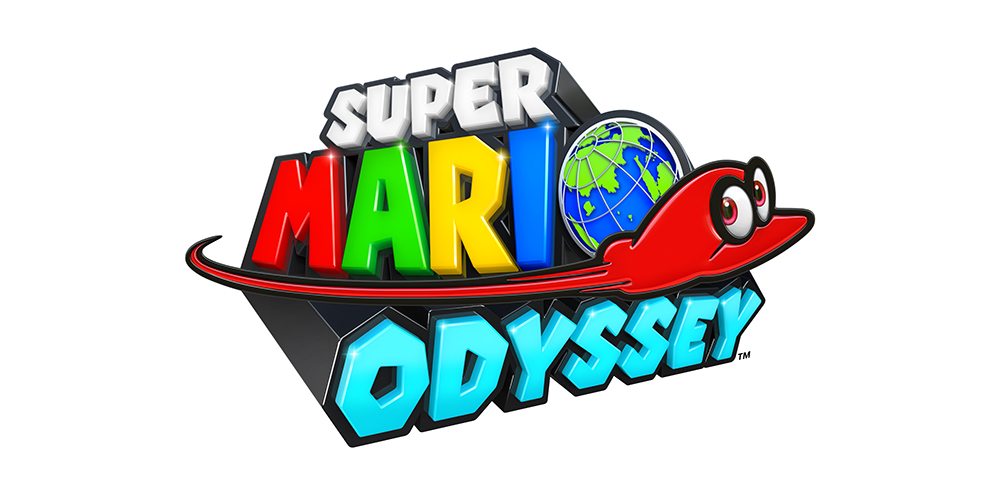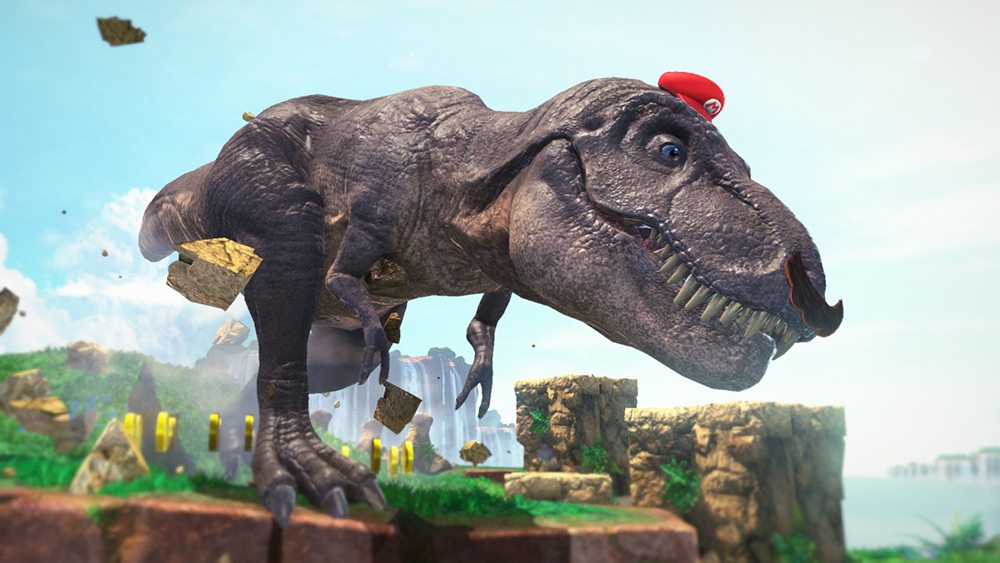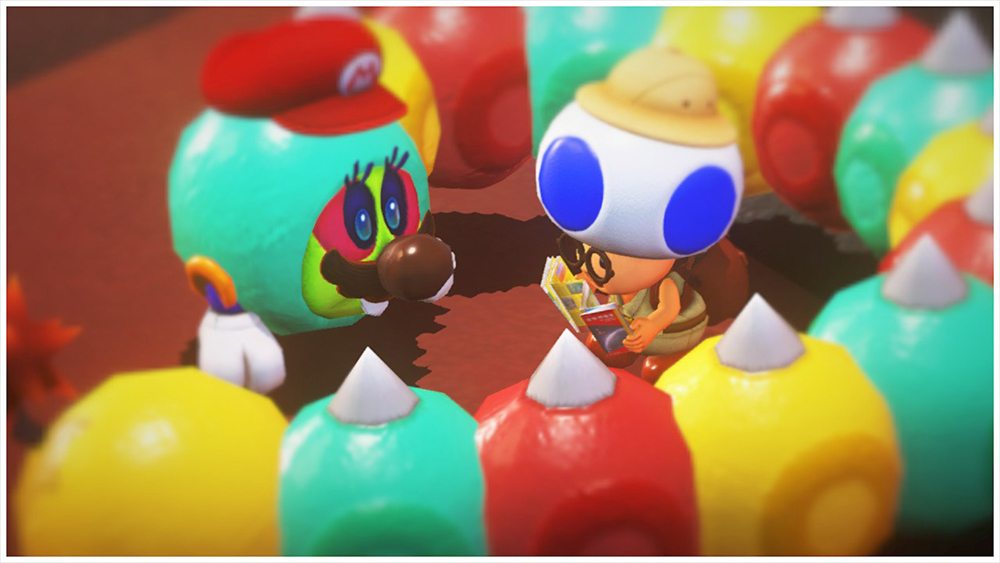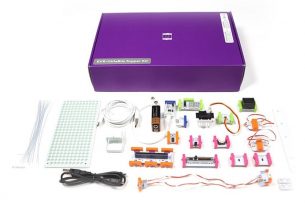
I have a bone to pick with Nintendo. No, I’m not having Joy-Con connectivity issues. I haven’t managed to irreparably scratch one of the many, many Nintendo-branded touchscreen gaming devices in my house. Nor am I being haunted by nightly dreams of that sinister Waluigi… anymore. My beef with NOA is that two of the company’s best Switch titles—namely Fire Emblem Warriors and Super Mario Odyssey—were released within a week of each other.
Of course, that’s a good problem to have. The best problem, some might say. This Friday, you too can experience this same glorious conundrum when Super Mario Odyssey hits store shelves. (You’ve already purchased your copy of Fire Emblem Warriors, right? Right?!)
Super Mario Odyssey Part 1: Put a Lid on It
As I discussed with director Kenta Motokura and producer Yoshiaki Koizumi in last week’s interview, much of the action in Super Mario Odyssey hinges on the unique functionality of Cappy, a new character that acts as Mario’s partner in this latest adventure. Bowser has captured Princess Peach by mesmerizing her using Cappy’s sister Tiara, so both parties have a genuine interest in stopping King Koopa’s high-flying wedding plans.

A ghostly, anthropomorphic top hat in his natural form, Cappy can change his appearance based on new hat types purchased at Crazy Cap shops located in each of the game’s distinct Kingdoms. Super Mario Odyssey uses a split currency system, with both traditional “gold” coins available throughout each realm as well as purple Kingdom-specific coins. Both types can be used at these similarly bisected haberdasheries to acquire new hats, matching costumes, and health-supplementing hearts as well as Power Moons and decorations for your airship.
Cappy’s assistance takes many forms. He can serve as a temporary platform, adding his might to Mario’s repertoire of platforming abilities like the traditional climb and wall jumpy; he can be thrown to snag collectables otherwise just out of reach; most impressively, though, he can be tossed at enemies to “capture” them, temporarily transferring Mario’s consciousness into everything from Goombas and Bullet Bills to local fauna like dinosaurs, thus unlocking their respective movement and attack abilities.
Super Mario Odyssey Part 2: Take to the Skies
Super Mario Odyssey has distinctly broad focus, but one element that seemed to crop up again and again in my play-through was the sense of flying. Cappy’s very nature, inspired by the movement of the Joy-Con itself, is steeped in flight, and you’ll find yourself tossing him like a boomerang at not just enemies but various environmental assets as well. He can clear a path through a patch of toxic ooze, activate rotating platforms, demolish wooden crates, and send barrels tumbling just to name a few.

There’s also the matter of the titular Odyssey. Mario and Cappy pursue Bowser through the skies using this special airship, collecting the necessary fuel, in the form of Power Moons, along the way. You must acquire a specific number of Power Moons in each Kingdom to advance to the next, and they’re often hidden near the apex of these beautifully vertical worlds—atop high buildings, around precariously twisting ledges, and even in tall trees.
As the game progresses, the Odyssey becomes weathered and customized both inside and out with the stickers, statues, and furniture you collect from various Crazy Caps. The segments of the ship’s central balloon also fill in as the story moves on. Personally, the sight of literally half of a hot air balloon effortlessly supporting a portly Italian’s mobile lair requires a bit of a willing suspension of disbelief, but you’re in hot pursuit of an amorous lizard-man hoping to marry and bamboozled mushroom princess, so perhaps verisimilitude isn’t particularly important here.
Super Mario Odyssey Part 3: Music Makes Me Lose Control
Super Mario Odyssey is a different kind of Mario game much in the same way Breath of the Wild is a brand new Zelda experience. This is reflected in its gorgeous art design that somehow makes a world in which deserts inhabited by Day of the Dead skeletons and bleak snowy wastes exist alongside deep underwater fissures full of mermaids and seemingly normal human cities seem like part of a greater, cohesive whole.

The gameplay, too, is delightfully varied. In addition to the sort of diversity you’d expect from a title that takes its protagonist from one end of the world to another, there are also pitch-perfect callbacks to Nintendo’s storied past. Using pixelated warp pipes, Mario can transform into Pixel Mario, an incarnation of our hero with a particularly old school twist. This 3D-to-2D shift has been done before—perhaps most obviously in The Legend of Zelda: A Link Between Worlds—but Super Mario Odyssey‘s 2D-platforming segments seemingly owe more to the madness of the NES Remix series. A noteworthy example, and one of the game’s biggest “Oh, wow!” moments, occurs in New Donk City. I won’t ruin the surprise, but suffice it to say the callback to Mayor Pauline’s early history during her performance of the game’s theme song “Jump Up, Super Star!” might be one of the most perfect entertainment moments of 2017.
Yet, while the level design and gameplay mechanics are blissfully expansive, SMO‘s control interface is noticeably less so. Sure, you can play it on your TV with a Pro Controller, on the go in Handheld Mode, or in any of the interstitial styles between the two—but Odyssey was designed to be experienced using two detached Joy-Cons. (And the game takes great care to remind you of this fact.) Many of the title’s most impressive controls involve swinging, shaking, or rocking a Joy-Con. These aren’t exactly impossible using more traditional controllers, but they are certainly more difficult, not to mention less intuitive.
Super Mario Odyssey Part 4: Better With a Friend
Since you have those Joy-Cons out, why not pass one to a child, a friend, or a significant other? Super Mario Odyssey makes jumping into two-player mode easier than ever. Available via the pause menu, it’s just a matter of making the selection and pressing the L+R buttons on the individual Joy-Cons to confirm.
By allowing your player two to control Cappy, you can act together to pull off more sophisticated platforming and combat. Cappy functions with an interesting sense of autonomy, flinging himself out challenge enemies or bust through obstacles or simply hover in a convenient location. He can also snap back with a single button press, flipping Mario into the air for a bonus super-jump.

This truly is pop-in/pop-out multiplayer, and you can switch between the two modes as the interest and temperament of your audience dictates. A second player proves especially useful during the game’s regular mini-boss battles against the Broodals, a team of particularly cantankerous lagomorphs who are, as my son was quick to remind me in his drollest tone, not at all like Ubisoft’s Rabbids.
My only advice? Make sure to reenter the pause menu and choose single-player before reattaching the Joy-Con controllers to the Switch tablet to avoid any unnecessary head-scratching regarding the suddenly puzzling joystick orientation.
Super Mario Odyssey Part 5: A True System-Seller
I’ve been encouraging folks to get onboard the Nintendo Switch hype-train since I returned from Manhattan in January. Breath of the Wild was a joy, Mario Kart 8 Deluxe was Wii U throwback favorite, Splatoon 2 was a fitting sequel to one of my most beloved new properties, and Fire Emblem Warriors… well, I had a lot to say about that one.
But let’s put all that aside for a moment. (Yes, even FEW.) Let’s say that you’re not already a Switch owner. Maybe you never picked up the Wii U or even the 3DS. Maybe you haven’t owned a Nintendo system since the Wii, the N64, or the SNES.
If you’re tempted to pick up a Switch console for the kids for the holidays off the shelf at you local Target or scoop up one for yourself from Amazon—where they’re now regularly in stock at MSRP—then I urge you to do so. And grab a copy of Super Mario Odyssey too.

The game makes major changes to age-old Super Mario formula by allowing you to zip through a bustling metropolis on a tiny orange scooter and toss your hat onto a T-Rex to take control of it. But it also alters gameplay in small but meaningful ways. Linking your coins to Mario’s life—you lose 10 each time he dies—finally makes the rote task of collecting them feel meaningful. Adding to and changing your wardrobe, while generally just a cosmetic tweak, actually plays into some of the story missions, requiring you wear the correct ensemble to access a specific portion of the map. Even something as simple as the game’s gorgeous character designs and dazzling graphics—and Nintendo has long preached function over form when it comes to in-game visuals—make even these well-known characters seem more expressive, more human.
There’s going to be a lot of talk over the coming weeks about Super Mario Odyssey, and I have no doubt that the vast majority of it will be positive. But the proof, as is the case with so many things, is in experiencing it for yourself, and whether you’re a lifelong fan or a recent convert, an early adopter or a brand new Switch buyer, I urge you to do just that.
Review materials provided by: Nintendo of America




